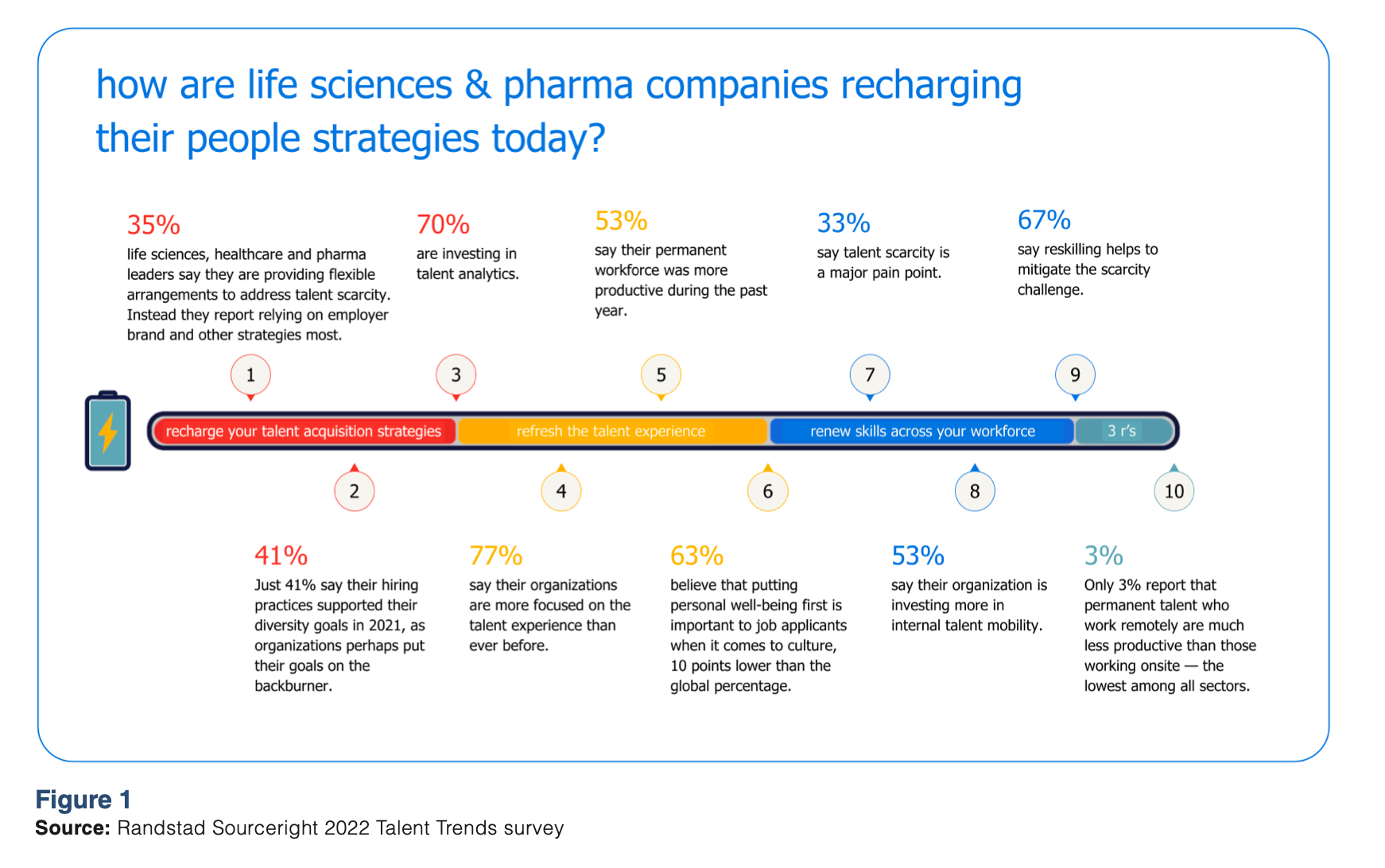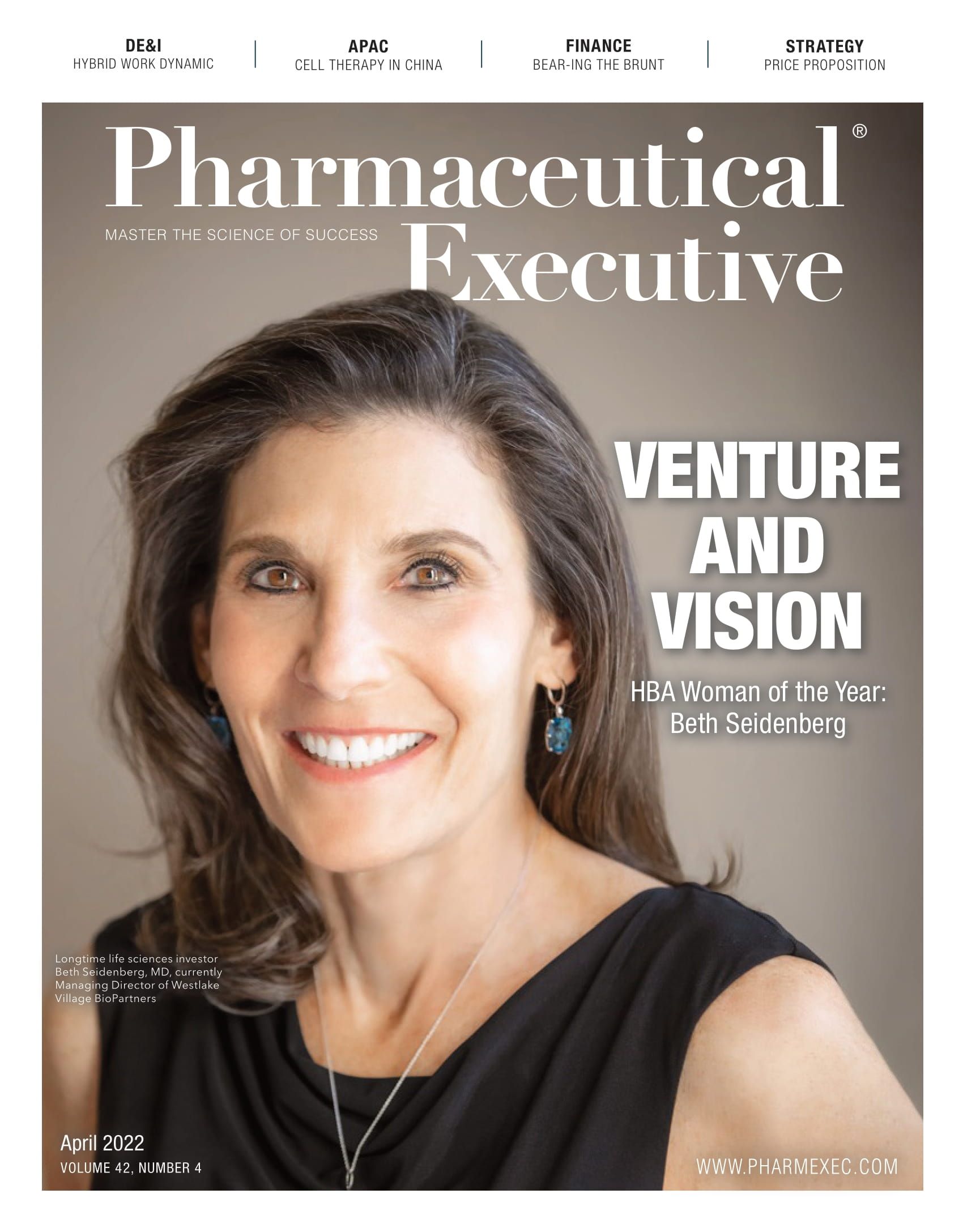Advantage Pharma: Capitalizing on Workforce Lessons
With an increase in drug development, why purpose should be the pharma industry’s secret advantage in the global talent shortage, as the COVID-19 crisis transitions into the endemic stage.

During the COVID-19 pandemic, the pharmaceutical industry showed the world that innovation could move safely at a swift pace to urgently meet demand for vaccines, therapies, and treatments. With the world watching, drugmakers delivered various technologies to combat the biggest epidemic since the Spanish Flu of 1918. Key to this unprecedented achievement is the talent assembled by pharma giants to not only develop and test but also globally distribute billions of doses at warp speed.
This remarkable accomplishment couldn’t have been possible without the commitment of people and effective talent strategies. At some companies, the prioritization of COVID meant shifting the focus of researchers, clinical trial specialists, safety officers, manufacturing workers, and many others to the development and distribution of these critical products. The ability of drugmakers to deploy the right people seemingly overnight is another testament to a new way of working.
But as the crisis now moves into the endemic stage, how can pharma organizations leverage the workforce lessons learned from the pandemic to enhance and accelerate product development in the future? And with worsening talent scarcity challenging organizations’ ability to fully provide the resources they need, can they actually capitalize on these learnings?
Competing for talent across industries
According to IQVIA Institute for Human Data Science, global spending on medicines is projected to grow as much as 6% CAGR by 2026, reaching a high of $1.8 trillion. Despite the disruptions brought on by the pandemic, some 300 new drugs are expected to launch, a figure that is markedly higher than seen in the previous decade.
This translates into strong demand for talent. According to one research report released last year, employment in the US life sciences industry reached a record high in March 2021, with job growth eclipsing that of even the technology sector. Total industry employment in the US was well over one million. The report also found that demand for lab and R&D space is at record highs, up 34% since mid-2020.
With such ambitious growth plans in sight, pharma manufacturers will also need to step up their efforts to attract and hire a variety of roles, from researchers to chemists to sales representatives to technology experts.
Even as demand for traditional skills remain robust, life sciences companies are under greater pressure to acquire digital specialists with expertise in:
- Bioinformatics
- Cloud computing
- Blockchain
- Artificial intelligence and machine learning (AI/ML)
- Augmented reality and virtual reality (AR/VR)
- Quantum computing
The challenges associated with some of these roles is that many other sectors are recruiting for the same skills, and competitors often have better recognition among the labor force. Silicon giants such as Google, Apple, IBM, and others naturally have stronger employer brands in the digital space than even the best-known businesses in the pharma industry.
As drugmakers shift their focus in the post-pandemic era, human capital leaders will also need to reassess the skills their organizations require today and in the future. For instance, a continuing trend in total patient care means companies are expanding the scope of their strategy to include prevention, screening, diagnostic, treatment, and aftercare. The skill set needed for this approach will also expand as well. The march toward individualized therapies is taking research into new directions as well.
On the operational side, the use of predictive analytics to model clinical trials, the automation of data management, and more agile project management techniques will drive the talent strategies of many human resources leaders. More importantly, companies will need to consider how best to differentiate their business from direct and indirect competitors.
Offering purpose and flexibility to attract talent
The appeal of working in the drug-making business has always been its purpose: to save and improve lives. This was made even more clear during the pandemic. Even so, the Great Resignation showed that professionals everywhere are reassessing their career choices and whether their jobs satisfy their professional and personal needs.
Feeling purposeful at work has been a top priority for job seekers since the pandemic arrived, Randstad’s Workmonitor survey of more than 27,000 workers in 34 markets shows. A majority (70%) said the pandemic gave them more clarity about their goals, and two-thirds have been inspired to make changes to their careers.
Does the life sciences and pharma sector do a good job of conveying purpose to job candidates? Unfortunately, no, according to human capital and c-suite leaders in the industry. Randstad Sourceright’s 2022 Talent Trends survey of 900 executives in 18 markets shows that only one-third of life sciences and pharma organizations think job seekers see their company as having a strong purpose and clear vision. For all sectors, the total was 75%, so the sector is woefully behind others.
Despite this, a large majority (80%) of life sciences and pharma companies believe they are articulating a strong employee value proposition and employer brand. A majority (57%) are also investing in workplace culture, employee feedback and engagement systems. Most (53%) are also using technology to improve how talent is recruited. And 77% say they are more focused on creating a more positive talent experience than ever before.
As they reassess the role of work in their lives, people are looking to employers to help them achieve the balance they seek. As a result, one in three employers across all sectors surveyed in the research say they’re offering flexible working arrangements to address talent scarcity, with 86% rating this as an effective strategy. While, in the past, the life sciences sector has been reluctant to offer such a perk, employers may have to reconsider this arrangement for roles that can be performed offsite some or all of the time.
More ways to beat the talent shortage
While providing purpose and flexibility will be critical to talent attraction, there is no one answer to the talent scarcity challenge. Here are four more ways you can gain an advantage:
1. Leverage contract-to-permanent opportunities for contingent labor. Contingent and contract arrangements give you the chance to “try before you buy.” Already, some of the largest pharmaceutical companies that Randstad Sourceright supports have expressed a desire for this approach to achieve greater agility, cost savings, and access to talent, especially in high-demand niche skills in research, clinical, and regulatory. In today’s tight labor market, companies should consider all forms of work arrangements that will broaden their talent pool and accelerate time to acquisition.

2. Build your own talent communities for freelancers. We have observed a growing number of organizations are increasing their investments in talent communities. Sixty-three percent of life sciences and pharma companies surveyed say they are increasing either moderately or significantly. This is a highly effective strategy for employers with a strong marketplace presence and overall employer brand, such as those in the pharma industry. A proven, highly engaged talent community that has already bought into your brand and knows your culture and requirements can be a huge flexible lever to pull in this tight talent market.
3. Grow your own. Investing in your current employees with upskilling programs can pay off. How can you elevate the skill sets of your different teams? What do they need to learn to continue to be valuable contributors? Sixty-seven percent of life sciences and pharma companies believe reskilling and upskilling employees for different roles is an effective way to address talent scarcity. Prioritize roles that need immediate skilling support by determining how quickly technology or ways of working change. Also identify pools of talent with skills adjacent to the ones you need so you can develop an appropriate learning and development strategy.
4. Focus on diversity, equity, and inclusion (DE&I). According to this year’s Randstad Sourceright research, just 60% of life sciences and pharma companies say DE&I were fundamental to attracting, engaging, and retaining talent—16 points lower than the global average across all sectors. But a focus on workforce diversity can widen talent pools, and ensuring equity and inclusion at work can drive retention. In fact, 57% of life sciences and pharma companies say that DE&I has helped them gain access to a broader range of talents, skills, and experiences. Half say they’re better able to attract a more qualified workforce as a result of their DE&I efforts, and 40% are attracting a wider range of candidates to fill vacancies.
As the industry looks to drive market momentum post-pandemic, talent will be key to future innovation and product launches. By taking proactive steps to bolster their ability to attract and retain workers today, they can ensure a sustainable and deep pipeline of talent to support their growth ambitions.
Alp Perahya, President, integrated managed services and total talent programs, Randstad Sourceright
